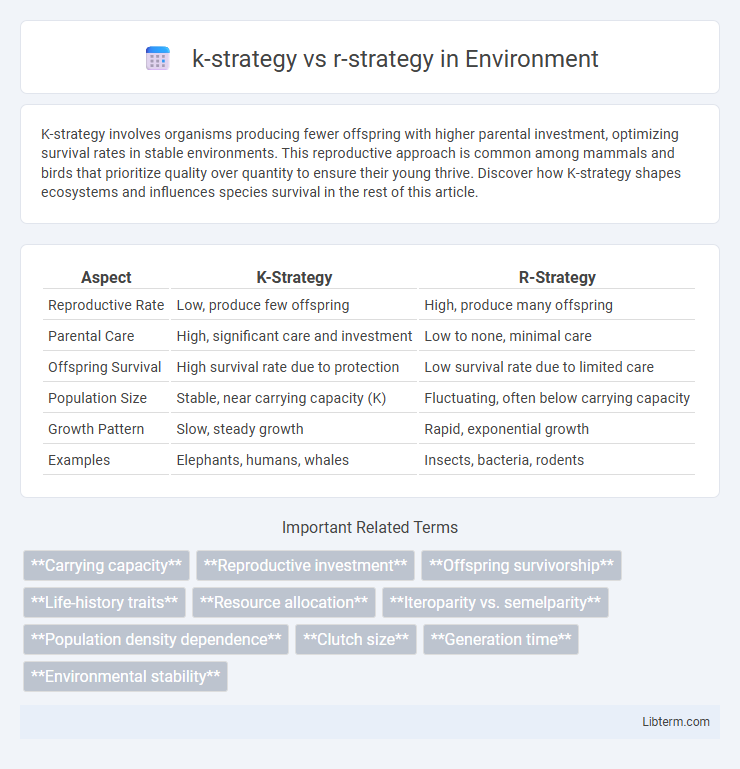K-strategy involves organisms producing fewer offspring with higher parental investment, optimizing survival rates in stable environments. This reproductive approach is common among mammals and birds that prioritize quality over quantity to ensure their young thrive. Discover how K-strategy shapes ecosystems and influences species survival in the rest of this article.
Table of Comparison
| Aspect | K-Strategy | R-Strategy |
|---|---|---|
| Reproductive Rate | Low, produce few offspring | High, produce many offspring |
| Parental Care | High, significant care and investment | Low to none, minimal care |
| Offspring Survival | High survival rate due to protection | Low survival rate due to limited care |
| Population Size | Stable, near carrying capacity (K) | Fluctuating, often below carrying capacity |
| Growth Pattern | Slow, steady growth | Rapid, exponential growth |
| Examples | Elephants, humans, whales | Insects, bacteria, rodents |
Introduction to K-Strategy and R-Strategy
K-strategy and R-strategy represent two distinct reproductive strategies in ecology that influence species survival and population dynamics. K-strategy species tend to produce fewer offspring with higher parental investment, thriving in stable environments near the carrying capacity (K). R-strategy species focus on producing large numbers of offspring with minimal care, enabling rapid population growth in unpredictable or fluctuating environments.
Defining K-Strategists: Characteristics and Examples
K-strategists exhibit traits such as slower growth rates, longer lifespans, and fewer offspring with higher parental investment, allowing for increased survival rates. These species thrive in stable environments where competition for limited resources shapes their reproductive strategies. Classic examples include elephants, humans, and oak trees, which prioritize offspring quality over quantity to maximize long-term survival.
Defining R-Strategists: Characteristics and Examples
R-strategists exhibit rapid reproduction with high offspring quantity but low parental investment, adapting to unstable environments that favor quick population growth. Common characteristics include short lifespans, early maturity, and minimal care for offspring, maximizing reproductive output over survival rates. Examples of r-strategists include bacteria, insects like fruit flies, and rodents, which thrive in unpredictable habitats by exploiting transient resources.
Environmental Influences on K- and R-Strategists
Environmental factors significantly influence the prevalence of K-strategists and r-strategists within ecosystems. K-strategists thrive in stable environments with limited resources, favoring traits like slower reproduction and enhanced parental care to maximize offspring survival. In contrast, r-strategists dominate in unpredictable or disturbed habitats, employing rapid reproduction and minimal parental investment to exploit transient resource availability.
Reproductive Strategies: Quality vs. Quantity
K-strategy emphasizes producing fewer offspring with higher parental investment, ensuring greater survival and competitive ability in stable environments. R-strategy favors producing many offspring with minimal investment, maximizing reproductive potential in unpredictable or rapidly changing conditions. This contrast highlights the evolutionary trade-off between offspring quality and quantity in reproductive strategies.
Lifespan and Survival: K-Selection vs. R-Selection
K-strategy species exhibit longer lifespans and invest more energy in offspring survival by producing fewer, well-developed young with higher parental care, ensuring greater chances of reaching adulthood. In contrast, r-strategy species have shorter lifespans and prioritize rapid reproduction by producing many offspring with minimal parental investment, leading to higher mortality rates but greater population growth potential. This fundamental difference in lifespan and survival tactics influences their adaptation to stable versus unpredictable environments.
Ecological Niches and Adaptation
K-strategy species thrive in stable ecological niches where competition for resources is intense, adapting through traits like longer lifespans, delayed reproduction, and parental care to ensure offspring survival. R-strategy species excel in unpredictable or disturbed environments by producing numerous offspring with minimal investment, maximizing rapid population growth and colonization potential. These contrasting reproductive adaptations reflect evolutionary responses to niche stability and resource availability, shaping species survival strategies.
Evolutionary Advantages and Trade-Offs
K-strategy organisms invest heavily in fewer offspring, enhancing survival rates through parental care and resource allocation, which benefits species in stable environments. R-strategy species produce many offspring with minimal investment, maximizing reproductive success in unpredictable or rapidly changing habitats. The evolutionary trade-off involves balancing offspring quantity versus quality, where K-strategists optimize survival under competition and r-strategists exploit opportunities for rapid population growth.
Human Impact on K- and R-Strategist Populations
Human activities significantly affect K-strategist populations, which have slower reproduction rates and longer lifespans, making them more vulnerable to habitat loss, pollution, and overexploitation. Conversely, R-strategist populations, characterized by rapid reproduction and high adaptability, often experience population booms in disturbed or altered environments caused by human influence, such as urbanization and agriculture. These dynamics highlight the importance of conservation efforts targeting K-strategists to maintain biodiversity and ecosystem stability amidst increasing anthropogenic pressures.
Conclusion: Balancing K-Strategy and R-Strategy in Nature
Balancing K-strategy and R-strategy in nature reflects adaptive survival mechanisms where species optimize reproductive success based on environmental stability and resource availability. K-strategists prioritize quality offspring with high parental investment, thriving in stable ecosystems, while r-strategists produce numerous offspring with minimal care, excelling in unpredictable or rapidly changing habitats. Understanding this balance informs ecological management and conservation by highlighting how species adjust reproductive strategies to maximize population resilience.
k-strategy Infographic

 libterm.com
libterm.com